Sun's W2100z Dual Opteron Workstation
by Kristopher Kubicki on October 27, 2004 12:05 AM EST- Posted in
- Systems
Thermals, Noise
Sonic
Having spent a considerable amount of time working on high end workstations in the past, the nagging thermal and audible "gotchas" are not issues to overlook. Many workstations perform outstanding when compared to an equivalent desktop setup, but they sound like a helicopter taking off. As we mentioned previously in the analysis, we were impressed by the simplicity and elegance of the w2100z internals. The true test of their worth seems to be when we start up the system and actually start using it. When we first set up our w2100z and the machine POST for the first time, we were greeted by the 120mm fan running at full speed, well above 50dBA! Fortunately, the initial fan speed setting seemed to only be part of the initial self-diagnostic test, and we never hear the fan peak over 30dBA for the rest of the analysis.Above, you can see the sole source of the w2100z's exhaust. If you look really closely at the EMI shield, you can see where the PS/2 ports are covered up still.
By contrast, our whitebox server setup is almost always running at or above 50dBA. The form factor is considerably different and the machine is more accustomed to sitting in a rack than on our desk. The comparison is apples to oranges, but our w2100z never makes the same amount of noise as our whitebox configuration.
Thermal
Equally important to any audible testing is a thermal analysis. We should approach any thermal testing in the same manner that one would approach any other enclosure review. In our previous enclosure analyses, we generally prefer bigger, slower moving fans over smaller, faster ones. It has been scientifically proven that when two sounds of equal dBA are compared side by side, humans tend to perceive the one with a higher pitch as "louder". Based on this premise, and the premise that larger fans move air over a larger area than smaller ones, Sun's layout for their exhaust makes a lot of sense. During our review, we did not see the fan peak over 2500 RPM, and generally, it averaged around 1100 RPM. 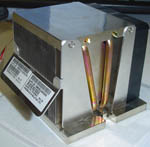 |
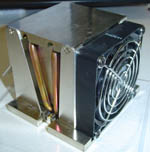 |
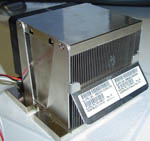 |
| Click to enlarge. | ||
Sun's heatsink/fan (HSF) combos are made almost entirely of aluminum, but unique because they employ a side fan and a system of heat pipes. Lately, every third-party manufacturer seems to have some heat pipes in their CPU coolers, so we weren't particularly surprised that they were adopted in the w2100z as well. The heatsinks play an integral role in Sun's very carefully designed thermal footprint - they are both placed in line with the 120mm exhaust and the second heatsink has fins to vortex hot air into the path of the 120mm fan. These small, professional attentions to detail compose part of our good impression confirming Sun's ability as a premiere workstation designer.
We added some other test points for this review to provide everyone with some thermal cross sections. The first graph shows the ambient air temperature taken from a sensor attached just off the inner wall of the side panel. You may download the CSV worksheet with each individual location tested here (under load). All positions on the graph below are measured using a digital thermometer with remote sensors at a constant ambient temperature of 22.3 degrees Celsius. After 30 minutes of looping SpecViewperf 8, we measured our workstation.
You can see that the warmest ambient air resides near the bottom of the case. As we expected, there are pockets of warm air grouping around the video card and hard drive where we have no active cooling moving air around. Most importantly, the AGP, PCI-X and SCSI tunnels are operating at significantly high temperatures and contributing to this warm air pocket. You can see the graph below, which denotes various surface temperatures of some of the components in the system. Hovering over the image reveals the temperatures of the CPU mezzanine as well.
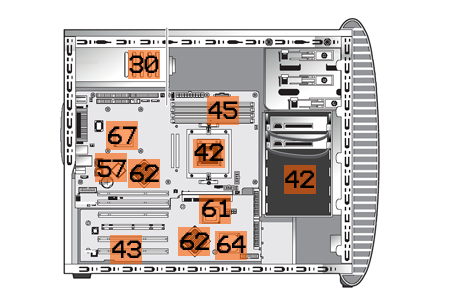
Hold your mouse over for the Overlay.
The CPUs themselves were both measured at 52 degrees Celsius under load, certainly not poor results. There is definitely a correlation between the surface temperatures of some of our components and the ambient air graph that we already saw. Temperatures on the SCSI controller and PCI tunnels are a little high and all of these components are passively cooled. Obviously, the components under the CPU mezzanine register as very warm, since they are not getting the benefits of the exhaust fan.
While testing the thermal components of the system, every time we removed the side panel, our rear exhaust fan shot up several hundred RPMs. Without the negative pressure pull across the inside of the case, the system almost immediately detects increased heat.


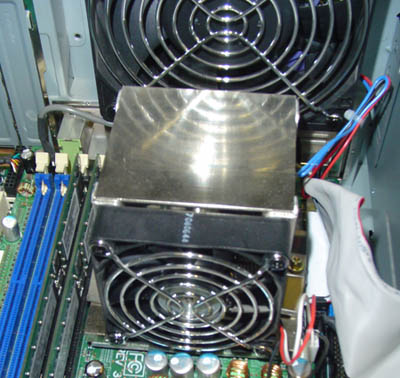
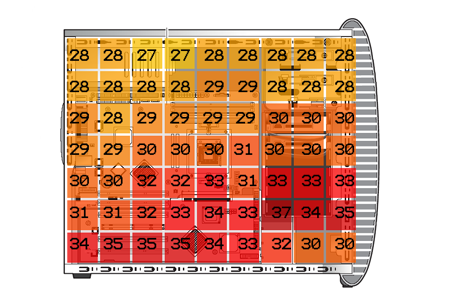








47 Comments
View All Comments
najames - Friday, October 29, 2004 - link
I use a Sunfire V440 daily at work. It is a 4cpu large entry level server seen here.http://store.sun.com/CMTemplate/CEServlet?process=...
I program daily on mainframe, Solaris, and PC. Benchmark programs I wrote took 38cpu seconds on the mainframe, 38cpu seconds on my PIII pc, 17cpu seconds on Solaris. Four programs submitted at once on the the mainframe took 38cpu seconds but wall time was hours, the PC choked, the Solaris server still did them in 17cpu seconds each in about the same wall time. The Solaris server didn't slow down, period. We have combined large programs that individualy would sometimes crash on the mainframe and the Solaris Unix server burns through them even with temp space going over 12gigs druing processing.
If the Sun Opteron server is anything like my little Sunny, they sould do very well.
Reflex - Friday, October 29, 2004 - link
*laff* Something tells me thats not the case.My curiosity is just that since these are obviously relabels, I am wondering who the original manufacturer is as the hardware is excellent and it might be nice to be able to acquire these for white box systems.
morespace - Friday, October 29, 2004 - link
Egad. You're absolutely correct. I didn't notice the daughterboard arrangement in that picture at first. It looks flat. But looking more closely at the placement of chips and capacitors on those motherboards, it's more than a family resemblance - they appear identical!I sense a conspiracy.
The hard drive enclosures appear different for what it's worth. Who makes these really? Apple?
Reflex - Friday, October 29, 2004 - link
I take that back, that is the same as the one I have on my bench, however their cabling is a bit more messy.Look closely. Anandtech did not show a straight out picture from the same angle, but thats the same motherboard in more or less the same chassis with a few modifications. The CPU, chipset, Adaptec chip, PCI and AGP slots are all in the same places on that board, both use the daughtercard method for the CPU, etc.
Thats why I am asking who actually makes that board and case, someone is preconfiguring the servers and Sun/IBM are labelling and reselling them.
Reflex - Friday, October 29, 2004 - link
That is not the same Intellistation that I have on my lab bench. I'll look up the model number when I go back in, but seeing as its friday night that won't be till monday.morespace - Friday, October 29, 2004 - link
Reflex, what are you on about? Here's a picture of the insides of an IBM Intellistation A Pro:http://www.digitalcad.com/articles/viewarticle.jsp...
Tell me, how does this look like a w2100z?
Nsofang - Friday, October 29, 2004 - link
Zealots on both sides always mess up any discussion. This is a review about the Sun WORKSTATION, yet punks bring in supercomputer arguments. WTF!! is wrong with you guys! If anything bring in arguments/discussions about comparable hardware G5's/Itaniums/NEC/SGI, something that adds to the discussion, not subtract.slashbinslashbash - Thursday, October 28, 2004 - link
#33: You're right, for "general purpose computing" FLOPS is a pretty bad measure, but you've just changed your argument. For "high-end workstations" (what this argument is supposedly about) FLOPS can be *very* relevant, depending on the application.#34: I meant "nothing special" in terms of how supercomputing clusters are normally hooked up. Just a few years ago, Gigabit Ethernet cards cost $200, and their most prominent application was in supercomputing clusters.
Reflex - Thursday, October 28, 2004 - link
#37: Yeah, I know, I was in a mood yesterday or I wouldn't have let him get me into it. ;)And you just made the point I was trying to make. While price can be an issue in the corporate space, its only the deciding factor when all other factors are equal. I was not even trying to get into a Mac vs. PC debate, this really has nothing to do with Mac's.
I do want to know who is building these workstations though, because its not Sun despite the label.
bob661 - Thursday, October 28, 2004 - link
Reflex,He's trying to pull you off the subject. Supercomputers are irrelevant in this discussion. The thread is about workstations. Sun markets workstations. Apple does not. I know our company doesn't care about a couple hundred or even a couple thousand dollar difference if the service is impeccable and the workstation performs the task without headaches.